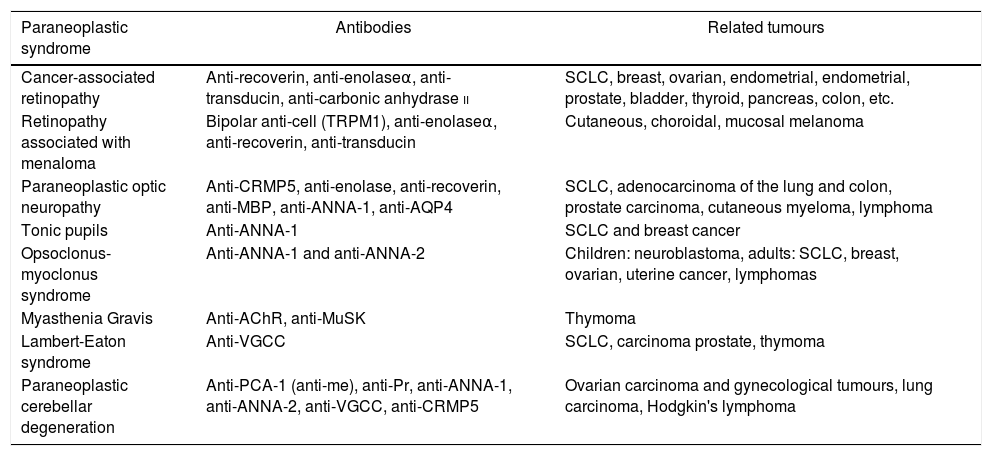Paraneoplastic syndromes consist on systemic manifestations associated with certain cancers which are not a direct consequence of tumor invasion or its metastases. It is known that autoimmunity and autoantibody synthesis play an important role in its pathophysiology due to a process of molecular mimicry. Paraneoplastic syndromes in ophthalmology are rare, but it is important to recognize them clinically because in some cases symptoms preceded the diagnosis of an underlying neoplasia. Most frequently involved cancer is small cell lung carcinoma, but there is also a relationship with other tumor etiologies such as thymoma, gynecological tumors or neuroblastoma in children. Paraneoplastic syndromes with ocular involvement can be divided into those that affect the afferent visual pathway, such as cancer-associated retinopathy, melanoma-associated retinopathy, or paraneoplastic optic neuropathy; and the ones that affect the efferent visual pathway, such as bilateral tonic pupils, Myasthenia Gravis, Lambert-Eaton syndrome or paraneoplastic cerebellar degeneration. The presence of autoantibodies is helpful in clinical practice but negativity does not exclude this diagnosis. Although evolution and prognosis is linked to primary disease, in some cases specific treatment, usually immunosuppressive therapy, can help improving patients quality of life.
Los síndromes paraneoplásicos consisten en la afectación de órganos y tejidos alejados de un tumor primario, y que no son consecuencia directa de la invasión tumoral ni de sus metástasis. Se sabe que en su fisiopatología juega un papel importante la autoinmunidad y la síntesis de auto-anticuerpos debido a un proceso de mimetismo molecular. Los síndromes paraneoplásicos de afectación oftalmológica son una patología poco frecuente, pero es importante reconocerlos clínicamente debido a que en algunas ocasiones los síntomas derivados preceden al diagnóstico de la neoplasia de base. El tumor más frecuentemente relacionado con esta patología es el carcinoma microcítico pulmonar, pero también existe relación con otras etiologías tumorales como el timoma, los tumores ginecológicos o el neuroblastoma en niños. Los síndromes paraneoplásicos de afectación oftalmológica pueden dividirse entre los que afectan a la vía visual aferente, como la retinopatía asociada al cáncer, la retinopatía asociada al melanoma o la neuropatía óptica paraneoplásica; o a la vía visual eferente, como las pupilas tónicas bilaterales, la Miastenia Gravis, el síndrome de Lambert-Eaton o la degeneración cerebelosa paraneoplásica. Cada vez se conocen más auto-anticuerpos relacionados y su positividad es de ayuda en la práctica clínica, pero la negatividad no excluye el diagnóstico. Aunque su evolución y pronóstico va ligado al de la enfermedad causal, en algunos casos el tratamiento específico, habitualmente mediante terapia inmunosupresora, puede ayudar a mejorar la calidad de vida de estos pacientes.












